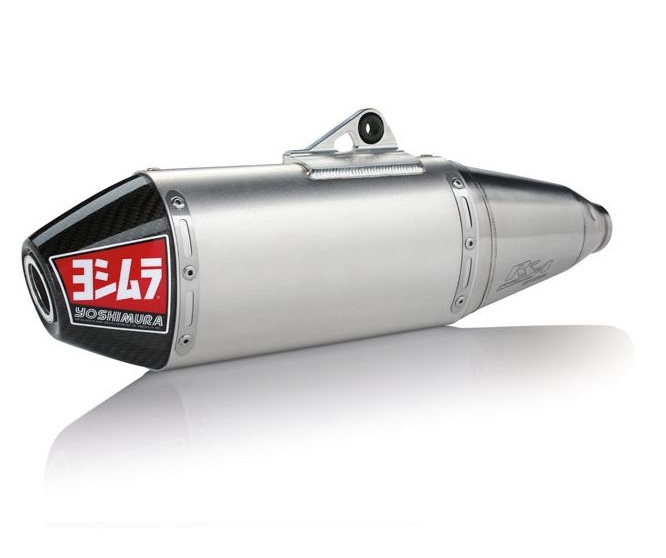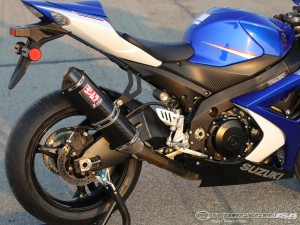Yoshimura Exhaust

Yoshimura exhaust pipes are the gold standard in high-performance motorcycle exhausts. From Yoshimura’s beginning in Japan in the middle of the 20th century to its expansion into the United States in the 70s to its rise as a worldwide name in top-end motorcycle exhaust systems, Yoshimura’s philosophy has revolved around the basic concept of uncompromising performance and superior aesthetics.
It’s an approach that’s been successful for Yoshimura, both in the world of racing and in its innovative exhaust product development. You can now find Yoshimura Exhaust models for sale online at most any bike parts retailer. This site contains the history of Yoshimura’s success, as well as useful tips on where to find Yoshimura exhaust parts, manuals, and more.
Yoshimura Exhaust Origins: “Pops” Yoshimura
Hideo Yoshimura was born in Fukuoka City, Japan, in 1922, and by the time Japan was fully engaged in World War II, he was ready to fly the Japanese military’s formidable fighter planes; he entered the Navy and began training as a pilot. An injury he incurred during training, however, kept him on the ground, so he did the next best thing and became an airplane mechanic, turning his innate ability to make machines do what he wanted them to do into a vocation.
After the war, Yoshimura settled into civilian life, and in civilian life their wasn’t much demand for a military airplane mechanic. Instead, he applied his skills to another class of high-performance machine: the motorcycle. He founded his self-named company in 1954, and he made a living tuning motorcycles for American servicemen stationed in Japan. His shop was a family business, with his children working both in the front office and in the shop, and soon Hideo became known to his kids and his customers as “Pops.”
By the beginning of the 1970s, Japanese bikes were becoming popular in the United States, and Pops saw an opportunity to expand his company into a bigger market. He moved to Los Angeles in 1971, and very quickly the reputation he’d earned in Japan was echoed by the reputation he established in America. He was 50 years old, and he was already known as one of the best bike tuners on two different continents.
Yoshimura Exhaust & Racing History
Yoshimura’s arrival in the United States coincided with the rise of the superbike era in American motorcycle racing, but it wasn’t an inexplicable coincidence. Yoshimura was almost immediately a major player on the new production-based superbike racing scene. In 1973, his name registered on the national racing scene when Yvon Duhamel won the AMA Superbike event at Laguna Seca on a Kawasaki Z-1 that Yoshimura had tuned.

Yoshimura had some racing success after the AMA established its official Superbike series in 1976, but things really heated up for the company in 1978, when Yoshimura began working with Suzuki bikes. A win at the 1978 Daytona Superbike race went to Steve McLaughlin, who rode a Yoshimura Suzuki GS1000. A year later, Yoshimura riders won the top three spots at Daytona, and Yoshimura won the next two Daytona races, too, for a total of four straight wins.
And it wasn’t just Daytona. Wes Cooley won the Superbike series title in 1979 and 1980 on Yoshimura bikes. In only a decade, Yoshimura had become one of the most formidable forces in motorcycle racing.
Yoshimura Present Day: Performance Products
All of the racing success served to support Yoshimura’s retail operation, which was focused on performance exhaust products. Although Pops was initially an engine builder, he understood that a key component of a high-performance engine was an exhaust system that could quickly and efficiently dispose of combustion gasses. Consequently, the company has been engaged in serious research and development of new exhaust products from its inception, and Pops’ ability to design and manufacture top-quality exhaust systems has become part of the corporate culture.
“The process takes as long as it takes,” the company’s philosophy explains. “When the finished pipe is right, everyone knows it and the design is locked up and goes to manufacturing. But you can’t put a clock on making the best pipes, you just have to make them.”
Yoshimura Exhaust Science: Velocity Technology

When he started building performance exhausts, Yoshimura used a hacksaw to cut pipes, a torch to heat them and his hands to bend them. The current company uses computers to design exhaust systems and CNC machines to cut and bend pipes. The use of technology isn’t just a labor- and money-saving proposition, though; the use of computer-controlled manufacturing processes allows the exhaust systems to be built to extremely tight tolerances, which helps them to perform better than those old hand-built pipes.
The company doesn’t see any acceptable substitute for hand-welding, however. Yoshimura uses robotic welding machines for steps in its production process, but when it comes to welding pipes, everything is done by hand, a standard that contributes much to Yoshimura’s reputation for quality.
The company’s adoption of technology extends beyond the manufacturing process to the products themselves. Yoshimura pipes aren’t just made out of steel any more; a full range of products takes advantage of a full range of high-tech materials, including stainless steel, titanium and carbon fiber.
Yoshimura Exhaust Applications
The full range of Yoshimura exhaust products also embraces a full range of small vehicle classes, not just racing bikes. Of course, the company still produces some the most respected exhaust systems for racing and road bikes, but it also manufactures a full line of exhaust products for off-road bikes, ATVs, UTVs and scooters.
In addition to its exhaust systems, Yoshimura also offers muffler repacking services, as well as kits for mechanics who want to do their own muffler repacking. For mechanics who need to service Yoshimura exhaust products, the company makes available a complete catalog of replacement mufflers and exhaust system parts.
Yoshimura’s Return to Japan
In 1981, Pops left his son Fujio in charge of the American operation and went back to Japan in order to concentrate on growing the Japanese business. Even during the time he was back in Japan, however, Pops made the trip across the Pacific and North America every year to attend Daytona. Eventually he retired, and Fujio took the helm of Yoshimura Japan; veteran mechanic Suehiro Watanabe took charge of US-based Yoshimura R&D. Pops died in 1995. He was inducted into the AMA Motorcycle Museum Hall of Fame in 2000.
Today, Yoshimura R&D remains committed as ever to building and refining performance products for fast bikes. You’ll find most major bike retailers stock Yoshi exhaust pipes, so ordering online is the easiest way to buy. Just remember! Always triple-check to make sure you’re buying the pipe that fits your specific bike. Click here to enter your bike info to ensure right fit. And if in doubt, check Yoshimura R&D’s website here. If you want to read more about the various Yoshimura exhaust models, click here.
Thanks for reading!